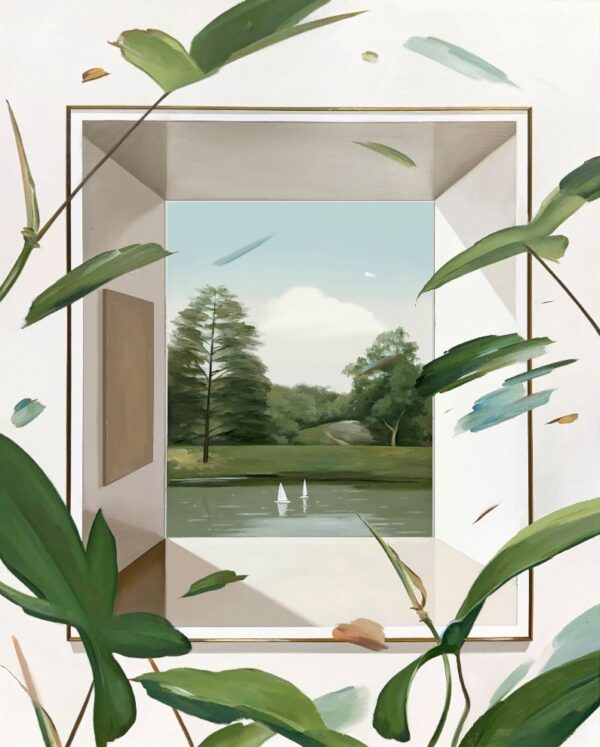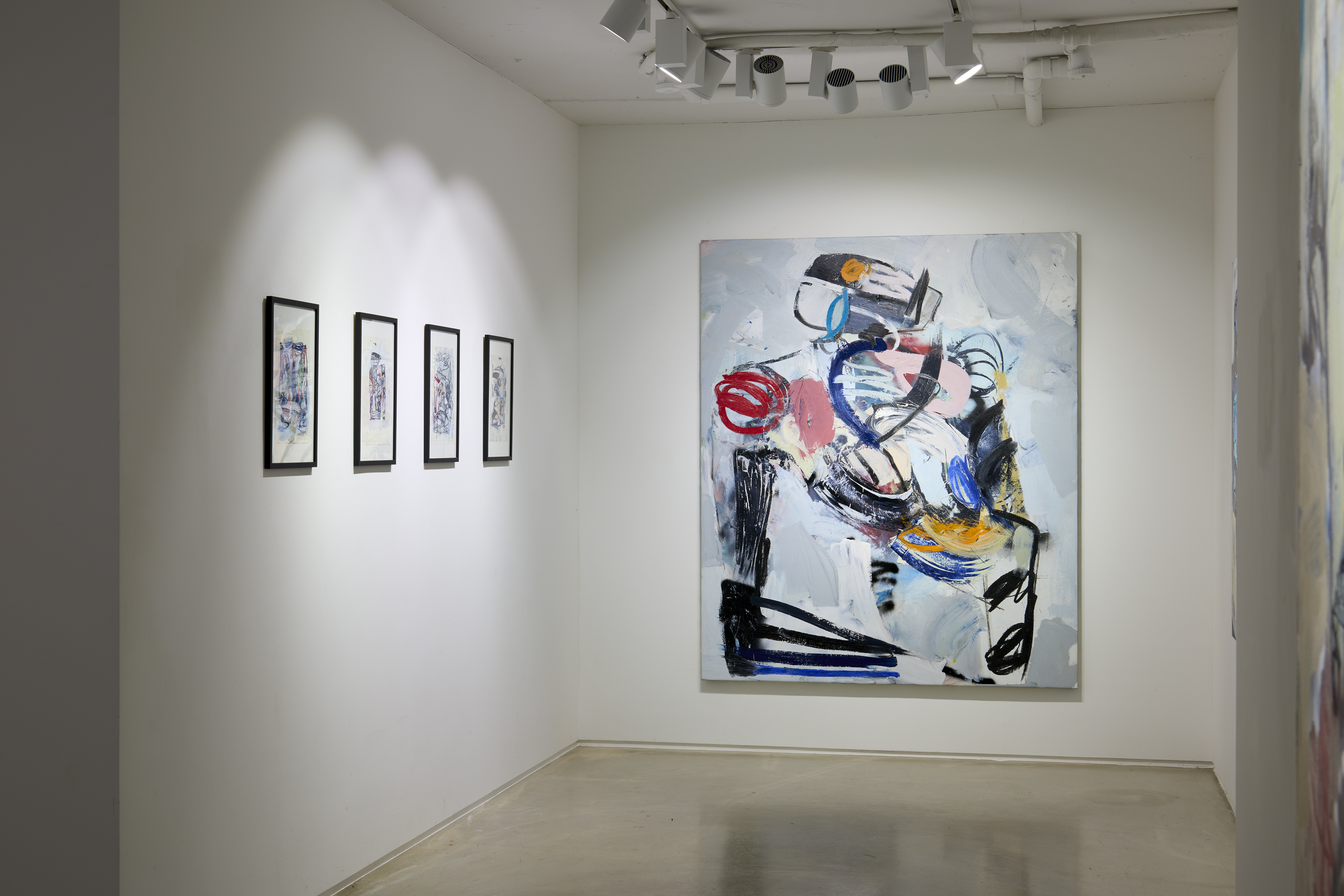파티는 여성이다
2024. 9. 4 - 10. 27 | [GALLERIES] Peres Projects Seoul
레베카 애크로이드

Installation view, Rebecca Ackroyd, ‘The Party Is A Woman’, Peres Projects, Seoul. Courtesy Peres Projects, Photographed by: Yangian
페레스프로젝트는 레베카 애크로이드(1987년 영국 첼튼햄)가 갤러리와 함께하는 네 번째 전시이자, 두 번째 서울 개인전인 ≪파티는 여성이다(Party Is A Woman)≫를 개최한다.

Installation view, Rebecca Ackroyd, ‘The Party Is A Woman’, Peres Projects, Seoul. Courtesy Peres Projects, Photographed by: Yangian
캔버스 회화와 종이 드로잉으로 구성된 이번 전시는 애크로이드의 최근 두 개인전인 하노버의 케스트너 게젤샤프트(Kestner Gesellschaft)의 ≪시대극(Period Drama)≫과 제60회 베니스 비엔날레 병행전 ≪거울 단계(Mirror Stage)≫에서 확장된 전시이다. 일상적인 것은 때때로 레디메이드 오브제를 포함하는 다차원적 구성에 스며들어, 현실에 산발적으로 닻을 내리는 역할을 한다. 여전히 일상에는 은유, 상징, 겹겹이 쌓인 타임라인으로 가득 차 있어, 간과하기 쉬운 것들을 새로운 시각으로 바라보도록 유도한다. 감거나 뜬 눈, 찢어진 스타킹, 식물의 줄기, 멍든 피부, 기계 조각 등이 해체되고 새로운 구조로 재구성되며 구상이 추상으로 녹아든다. 친숙한 모티프는 형이상학과 인간 경험의 토대를 성찰하는 수단이 되어, 자기성찰적 렌즈를 통해 덧없음, 기억, 존재, 정체성을 관찰하고 찰나를 확대하여 보이지 않는 것을 포착한다. 이러한 일상적 요소들은 과거와 현재를 수렴하고 내면과 외면이 교차하며, 시작과 끝이 겹치는 파편화된 스토리의 주인공으로 서 있다.

Rebecca Ackroyd, Resurrection, 2024, Drawing – Gouache, soft pastel on Somerset satin paper, 37 x 38 cm
레베카 애크로이드의 회화적 세계에는 그것이 무엇인지는 알 수 없지만 그 무언가를 인지할 수 있는 묘한 느낌인 기묘한 친숙함이 있다. 주제는 때로는 회화, 때로는 조각, 드로잉, 설치 등 매체에 따라 형태를 바꾸며 변화한다. 형태와 질감은 선명한 색상과 눈에 띄는 디테일을 통해 드러나지만, 결코 그 정체를 완전히 드러내지 않는다. 보는 이로 하여금 시각 이상의 감각을 동원하고 직관이나 기억에 의존하도록 요구한다. 이러한 무의식적인 내면의 인식이 바로 레베카 애크로이드가 관객을 끌어들이는 영역이며, 신체 조각, 얼굴 없는 유령, 엔진 부품 및 일상 주변을 채우는 생활용품으로 가득한 실물 크기의 풍경 속으로 관객을 빠져들게 한다.

Rebecca Ackroyd, Life expectancy, 2024, Drawing – Gouache, soft pastel on Somerset satin paper, 39 x 22 cm
여기서 시간은 결코 선형적이지 않다. 순환하고, 펼쳐지고, 수축하며 자주 등장하는 모티프인 시간이나 다른 시간을 암시하는 기기들을 통해 현재의 순간과 과거의 순간을 연결한다. 애크로이드의 작품에서 시계는 기념비적인 존재로, 숫자를 부분적으로 표시하거나 아예 표시하지 않으며, 시간을 알려주지 않고 그저 시간이 지나가고 있음을 알려줄 뿐이다. 터빈, 회전자, 활짝 핀 꽃은 거대한 나선형으로 묘사되어, 2차원 이미지 고유의 정적 속에서도 회전하는 존재인 동시에 불안정한 시대정신의 불안을 드러낸다. 애크로이드는 과거를 현재로 끌어들여 꿈이라는 불가해한 언어와의 만남을 연출함으로써 상상과 환각 사이의 초현실적이면서도 감각적인 영역을 만들어낸다.

Rebecca Ackroyd, tidal force, 2024, Painting – Oil on linen, 100 x 100 cm
이 연작에서 유기체는 엔진의 해부학적 구조와 마주하며 각각의 물성과 유사한 양면성을 보여준다. 이러한 조우에서 기계 개체의 근본적인 부드러움이 드러남과 동시에 인간과 식물 유기체의 기계적인 특성이 드러난다. 터빈은 부드러운 그라데이션으로 묘사되고 시곗바늘은 꽃잎 속에서 거의 휴면 상태에 있는 것처럼 물감층 사이로 희미하게 나타난다. 레베카 애크로이드는 전기 모터의 중심을 연상시키는, 마치 눈꺼풀과 홍채처럼 활짝 열린 꽃이나 닫힌 꽃을 그린다. 어떤 식으로든 이러한 유사점은 기술의 거부할 수 없는 힘에 무의식적으로 굴복하게 만드는 우리 일상 행동의 자동화에 대한 사유를 촉발한다. 그러나 애크로이드의 작품에서 기계는 악의적인 대상이 아니라 세심한 호기심으로 관찰되며, 어쩌면 우리를 기계와 연결하는 미묘한 동일성을 더 잘 파악하고 고찰하기 위한 것일 수도 있다.

Rebecca Ackroyd, The rose garden, 2024, Drawing – Gouache, soft pastel on Somerset satin paper, 65 x 91 cm
각성된 의식과 꿈 같은 환상의 경계에서 우리의 지각 균형을 유지하며, 우리가 실제로 알고 있다고 생각하는 것은 작가의 독특한 파편화와 재현 방식에 의해 변형된다. 연작, 반복되는 이미지, 패턴, 시각적 모티프의 재탐색은 세속적인 것과 영적인 것을 모두 아우르는, 일관되면서도 모호한 어휘를 만들어낸다. 이러한 창의적 접근 방식은 이미지, 물질, 형식의 본능적인 경험을 통해 보이지 않거나 쉽게 파악할 수 없는 것을 포착하는 것에 대한 관심을 드러낸다. 레베카 애크로이드는 서사와 매체가 교차하는 광범위하고 복잡하게 구성된 망을 엮어 놀라운 관점을 제공하고 사회적 관점 및 개인사 사이의 미묘한 교차점을 형성한다.
이 전시는 레베카 애크로이드와 페레스프로젝트가 함께하는 네 번째 전시이자 서울에서의 두 번째 개인전이다. 최근 개인전으로는 제60회 베니스 비엔날레의 공식 병행전이자 케스트너 게젤샤프트(Kestner Gesellschaft, 2024)가 주관한 개인전 ≪거울 단계(Mirror Stage)≫, 아담 부닥(Adam Budak)과 알렉산더 빌름쉔(Alexander Wilmschen)이 기획한 독일 하노버 케스트너 게젤샤프트(2023)의 ≪시대극(Period Drama)≫, 마티유 르리에브르(Matthieu Lelièvre)가 기획한 리옹 현대미술관(Musée d’art contemporain de Lyon, 2023)의 ≪Shutter Speed≫, 페레스프로젝트 서울(2022)의 ≪비옥한 땅(Fertile Ground)≫, 페레스프로젝트 베를린(2021)의 ≪100mph≫이 있다. 영국 리즈대학교 스탠리와 오드리 버튼 갤러리(The Stanley & Audrey Burton Gallery, 2023)의 ≪Contested Bodies≫, 산드라 파트롱(Sandra Patron)이 기획한 프랑스 보르도 현대미술관(CAPC musée d’art contemporain de Bordeaux, 2023)의 ≪Antéfutur≫, 마시밀리아노 지오니(Massimiliano Gioni)가 기획한 레바논 베이루트 아이쉬티 재단(Aïshti Foundation, 2022)의 ≪Dark Light, Realism in the Age of Post Truth≫, 페레스프로젝트 서울(2022)의 ≪봄(SPRING)≫, 베를린 펠레스 엠파이어(Peles Empire, 2022)의 ≪corpus murmur≫ 등에서 개최된 다수의 단체전에 참여했다.
페레스프로젝트 서울
대한민국 서울특별시 종로구 율곡로 1길 37
+82 0 2233-2335
[GALLERIES] Peres Projects Seoul
- Dates
- 2024. 9. 4 - 10. 27











